Download Earth Worksheets
Click the button below to get instant access to these premium worksheets for use in the classroom or at a home.
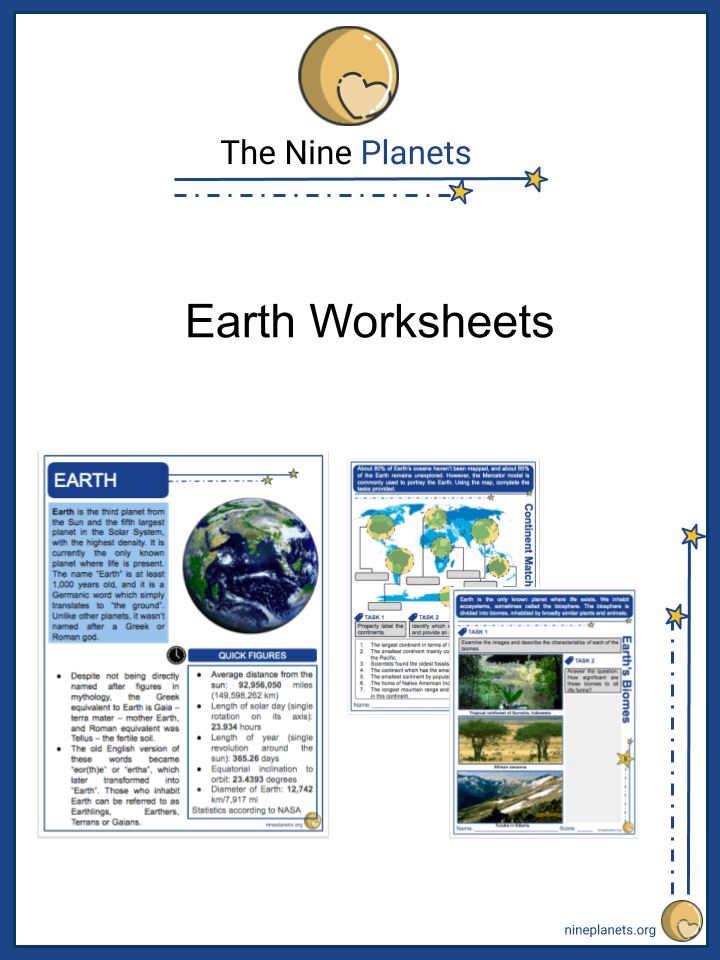
This worksheet can be edited by Premium members using the free Google Slides online software. Click the Edit button above to get started.
Download free sample
Not ready to purchase a subscription yet? Click here to download a FREE sample of this worksheet pack.
Resource Examples
Click any of the example images below to view a larger version.
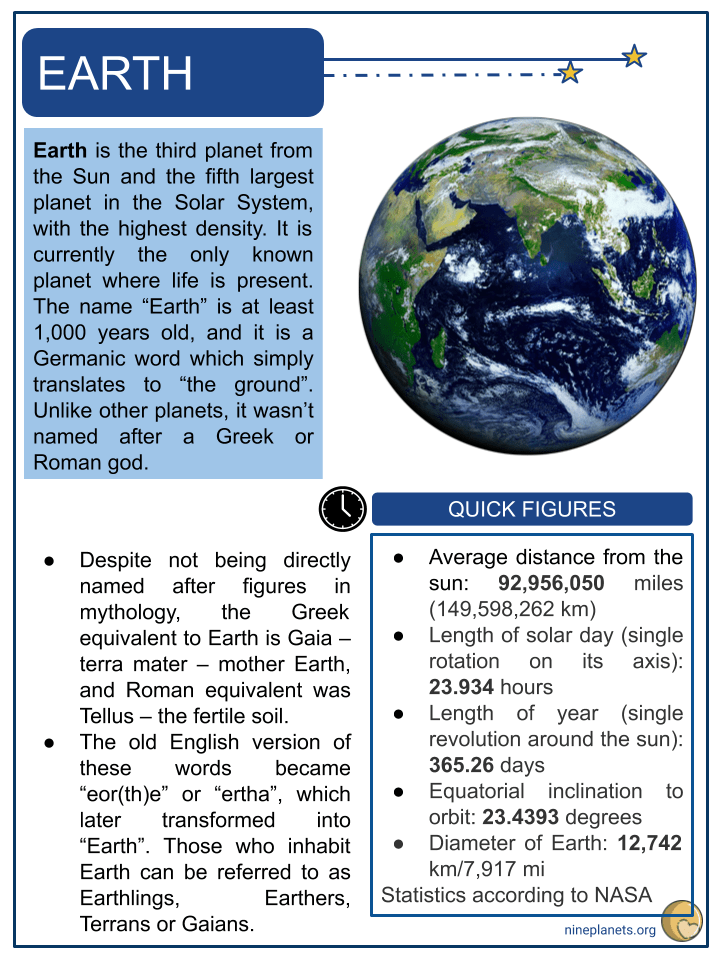
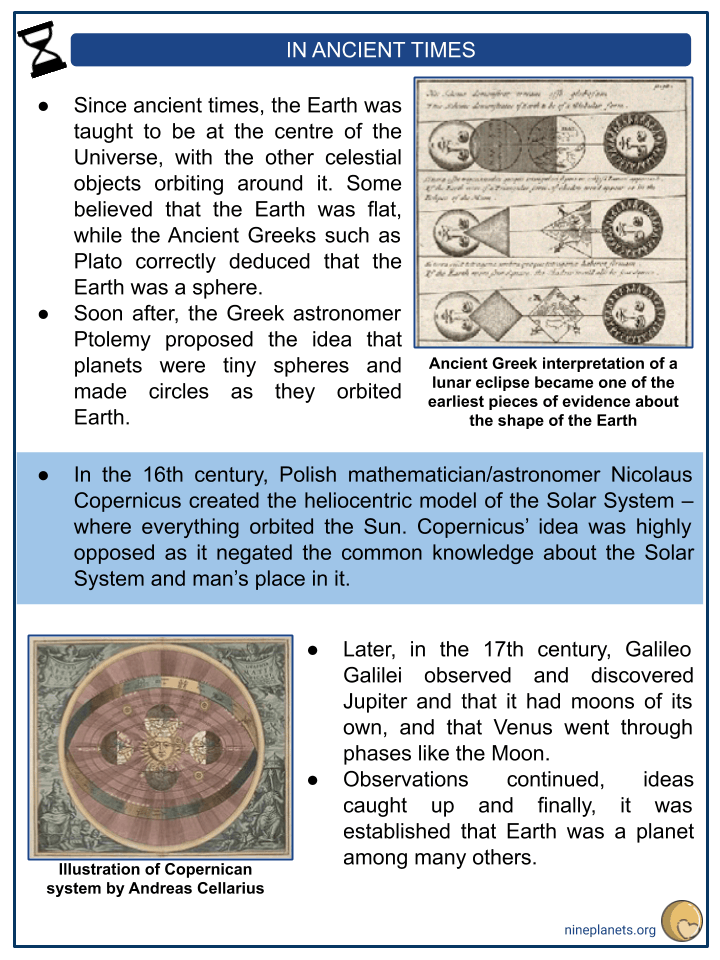
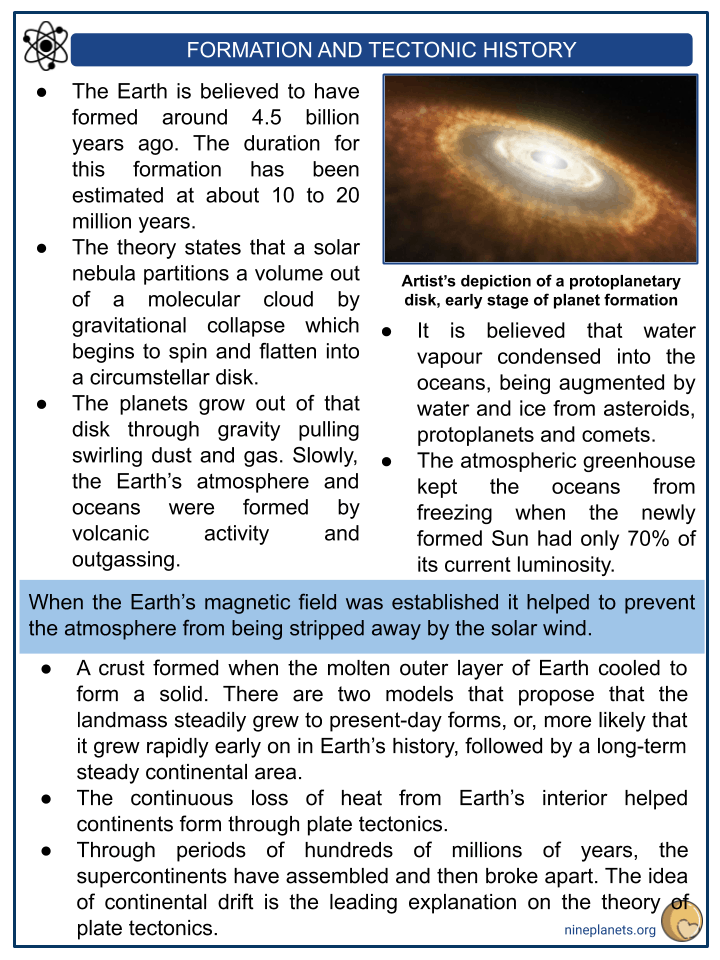
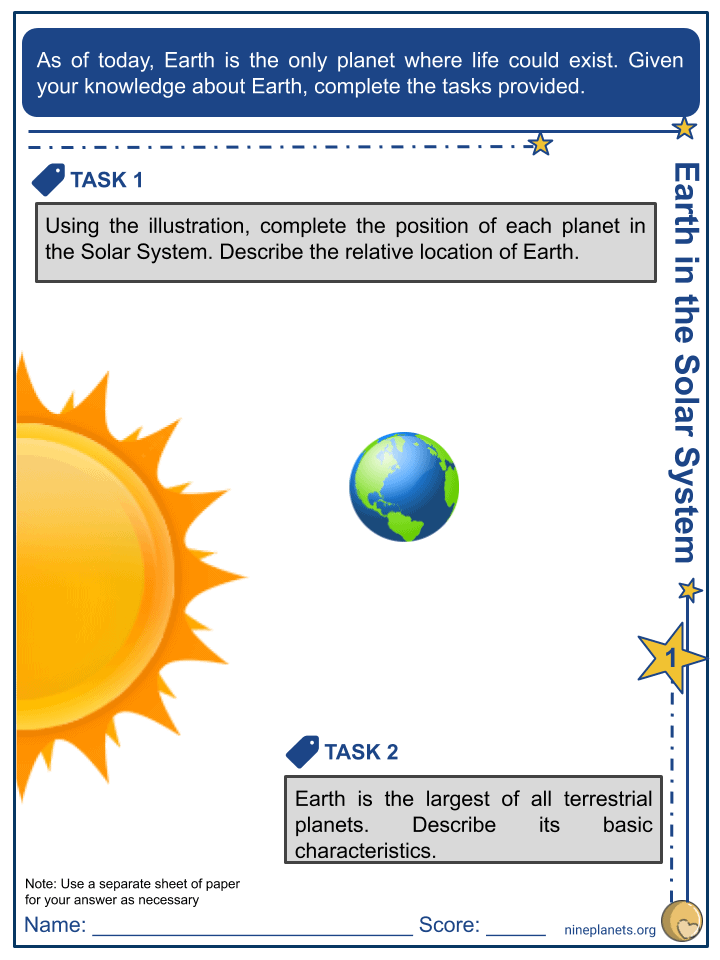
Key Facts & Information
- Earth is the third planet from the Sun and the fifth largest planet in the Solar System, with the highest density. It is currently the only known planet where life is present. The name “Earth” is at least 1,000 years old, and it is a Germanic word which simply translates to “the ground”. Unlike other planets, it wasn’t named after a Greek or Roman god.
- Despite not being directly named after figures in mythology, the Greek equivalent to Earth is Gaia – terra mater – mother Earth, and Roman equivalent was Tellus – the fertile soil.
- The old English version of these words became “eor(th)e” or “ertha”, which later transformed into “Earth”. Those who inhabit Earth can be referred to as Earthlings, Earthers, Terrans or Gaians.
Quick Figures
- Average distance from the sun: 92,956,050 miles (149,598,262 km)
- Length of solar day (single rotation on its axis): 23.934 hours
- Length of year (single revolution around the sun): 365.26 days
- Equatorial inclination to orbit: 23.4393 degrees
- Diameter of Earth: 12,742 km/7,917 mi
- Statistics according to NASA
In Ancient Times
- Since ancient times, the Earth was taught to be at the centre of the Universe, with the other celestial objects orbiting around it. Some believed that the Earth was flat, while the Ancient Greeks such as Plato correctly deduced that the Earth was a sphere.
- Soon after, the Greek astronomer Ptolemy proposed the idea that planets were tiny spheres and made circles as they orbited Earth.
- In the 16th century, Polish mathematician/astronomer Nicolaus Copernicus created the heliocentric model of the Solar System – where everything orbited the Sun. Copernicus’ idea was highly opposed as it negated the common knowledge about the Solar System and man’s place in it.
- Later, in the 17th century, Galileo Galilei observed and discovered Jupiter and that it had moons of its own, and that Venus went through phases like the Moon.
- Observations continued, ideas caught up and finally, it was established that Earth was a planet among many others.
Formation And Tectonic History
- The Earth is believed to have formed around 4.5 billion years ago. The duration for this formation has been estimated at about 10 to 20 million years.
- The theory states that a solar nebula partitions a volume out of a molecular cloud by gravitational collapse which begins to spin and flatten into a circumstellar disk.
- The planets grow out of that disk through gravity pulling swirling dust and gas. Slowly, the Earth’s atmosphere and oceans were formed by volcanic activity and outgassing.
- It is believed that water vapour condensed into the oceans, being augmented by water and ice from asteroids, protoplanets and comets.
- The atmospheric greenhouse kept the oceans from freezing when the newly formed Sun had only 70% of its current luminosity.
- When the Earth’s magnetic field was established it helped to prevent the atmosphere from being stripped away by the solar wind.
- A crust formed when the molten outer layer of Earth cooled to form a solid. There are two models that propose that the landmass steadily grew to present-day forms, or, more likely that it grew rapidly early on in Earth’s history, followed by a long-term steady continental area.
- The continuous loss of heat from Earth’s interior helped continents form through plate tectonics.
- Through periods of hundreds of millions of years, the supercontinents have assembled and then broke apart. The idea of continental drift is the leading explanation on the theory of plate tectonics.
- The idea of continental drift explains how a giant land mass or supercontinent called Pangaea, which existed about 240 million years ago, soon broke into two – Laurasia and Gondwanaland, during the Triassic period. The Jurassic and Cretaceous followed and created the continents we know today.
Composition
- Earth is the largest of the terrestrial planets and densest of all.
- Earth’s mass composition is mostly comprised of iron 32.1%, oxygen 30.1%, silicon 15.1%, magnesium 13.9%, sulphur 2.9%, nickel 1.8 %, calcium 1.5%, and aluminum 1.4%. The remaining 1.2% consists of trace amounts of other elements.
Key Terms
- Orbit – A regular, curved and repeating path through which objects in space move around a planet.
- Terrestrial planets – Planets which have a hard surface, made up of rocks or metals.
- Revolution – The Earth’s rotation around the Sun or the Moon around the Earth.
- Rotation – A circular movement of the Earth around its own axis.
- Leap year – A year which occurs every four years due to Earth’s revolution.
Earth’s Geology And Surface
- Earth has four main layers: an inner core at the centre, an outer core enveloping it, mantle, and crust.
- Since it has the greatest density of all the planets in the Solar System – 5.51 g/cm³ – and a gravity of 9.807 m/s² or 1 g, the Earth’s core is solid.
- It is made of iron and nickel about 759 miles / 1,221 kilometres in radius.
- The temperatures at the core have been estimated to be around 9,800 degrees Fahrenheit / 5,400 degrees Celsius, which is hotter than the surface of the Sun.
- Together with the inner core, Earth also has an outer core, with the crust being the mantle and the thickest layer. It is a viscous mixture of molten rock about 1,800 mi / 2,900 km thick and has the consistency of caramel.
- The outermost layer – Earth’s crust – goes about 19 mi / 30 km deep on average on land. But at the bottom of the ocean, the crust is thinner and extends about 3 mi / 5 km from the seafloor to the top of the mantle. The crust in a sense floats on the mantle due to lower density.
- It is not a solid piece but rather broken up into huge tectonic plates. These plates move, driven by the flow of rock in the mantle that is in turn powered by heat.
- Though the hot material rises towards the surface, it is blocked by the crust. The magmatic rock pushes on the plates, causing them to slide around slowly.
- Where the crust is weaker, magma can push its way through thus erupting onto the surface, forming volcanoes. Because of volcanoes, material wells out creating new land, and they also pump out gas that greatly contributed to Earth’s atmosphere.
- As such the core is so hot because of: leftover heat since the Earth’s formation; gravity’s squeezing effect, radioactive decay from elements such as uranium and friction.
- The surface area of Earth is about 197 million square miles / 510 million square kilometres. Around 71% of the surface is covered by water and 29% by land.
- The water is 3% fresh and 97% salted. Of that 3% freshwater, over 2% is frozen in ice sheets and glaciers meaning that less than 1% is freshwater found in lakes, rivers and underground.
- With regards to land, the continent of Asia covers about 30% of all the land, having around 60% of the world’s population. The Earth is divided into 7 continents that constantly “move” several centimetres every year.
- The highest altitude – elevation – on Earth is Mount Everest at 8,848 m \ 29,029 ft above sea level. The lowest point on land is in the Dead Sea – 420 m / 1,377 ft below sea level.
- Most volcanoes are hidden under these oceans. Hawaii’s Mauna Kea is a volcano much taller than Mount Everest, and even Earth’s longest mountain range – four times longer than the Andes, Rockies, and Himalayas combined – is underwater at the bottom of the Arctic and Atlantic oceans.
- There is a small flattening at the poles and bulging around the equator due to Earth’s rotation speed. This makes the shape of Earth approximately an oblate spheroid.
Earth’s Atmosphere And Biosphere
- The atmosphere of Earth is a layer of gas above the crust. It is not solid and thus it fades away with height. The line between Earth’s atmosphere and space is set at 100 km / 62 miles up. It is called the Kármán line. Technically, anyone who goes above it is an “astronaut”.
- The atmosphere by volume is about 78% nitrogen, 21% oxygen, 1% argon, and the rest an assortment of trace gases. Water vapour is also present, almost all of it below a height of about 8-15 km/ 4.9 – 9 mi.
- The atmosphere of Earth can be divided into 6 major layers:
- Troposphere – The lowest starting at ground level and extending upward to about 10 km / 6.2 miles. Most of the weather occurs here and most clouds are present.
- Stratosphere – It extends from the top of the troposphere to about 50 km / 31 mi above the ground. This is where the ozone layer is present. Unlike the troposphere, it gets warmer upwards which means a lack of turbulence favourable to commercial flights.
- Mesosphere – It extends upward to a height of about 85 km / 53 miles above the planet. Most of the meteors burn up in the mesosphere and unlike the stratosphere, the temperature drops again with the top temperature reaching about -90 degrees Celsius / -130 degrees Fahrenheit. The air here is far too thin to breathe and the pressure is well below 1% of the pressure at sea level.
- Thermosphere – A layer with very rare air and high-energy X-rays and radiation from the Sun being present but absorbed by the thermosphere. This raises the temperatures considerably and most satellites orbit the Earth in this layer. The auroras, Northern and Southern Lights occur in the thermosphere. The top of the thermosphere varies between 500-1,000 km / 311-621 mi above the ground.
- Exosphere – Considered the final frontier of Earth’s gaseous envelope. The air here is extremely thin and leaks into space. The top once again varies: 100,000-190,000 km / 62,000-120,000 mi above the surface of Earth. The latter value is about halfway to the Moon.
- Ionosphere – This is not a distinct layer like the previous ones. It is rather a series of regions in parts of the mesosphere and thermosphere where high-energy radiation from the Sun has knocked electrons loose from their parent atoms and molecules. The electrically charged atoms and molecules are called ions, endowing this region with some special properties.
- Earth is the only known habitable planet in the Solar System today. Life forms inhabit ecosystems, whose total is sometimes said to form a biosphere.
- The biosphere is divided into biomes, inhabited by broadly similar plants and animals.
- Biomes include tropical rainforest, temperate forest, desert, tundra, taiga, grassland, savanna, freshwater and marine.
Did You Know?
- The Moon orbits the Earth roughly as fast as a rifle bullet.
- The Earth is gradually rotating slower at about 17 milliseconds per 1,000 years. The Moon contributes to this and as Earth slows down, the Moon creeps away.
- The Earth is travelling through space at roughly 67,000 miles or 107,826 kilometres per hour.
- Earth has a lot fewer craters than the surface of most other planets. This is because the planet has lots of volcanoes and earthquakes which cause the highs and lows of the surface to sink or be worn down over time.
- The first picture taken of Earth from outer space was conducted by the Apollo 17 team. The original picture named The Blue Marble portrayed Earth upside-down. The image was later edited.
- The Earth’s magnetic field and its interaction with the solar wind also produce the Van Allen radiation belts, a pair of doughnut shaped rings of ionised gas (or plasma) trapped in orbit around the Earth.
- If space were a vacuum, Earth’s magnetic field would extend to infinity.